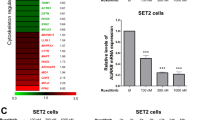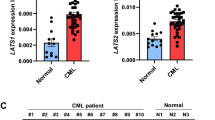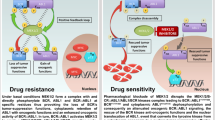Abstract
Chemotherapy resistance is a major challenge in acute myeloid leukemia (AML). Besides the P-glycoprotein efflux, additional cellular factors may contribute to drug resistance in AML. c-Jun N-terminal kinase (JNK) is activated after exposure of cells to chemotherapeutics. We asked whether chemoresistance in AML is attributed to intrinsic failure of the AML blasts to activate JNK. In vitro treatment of U937 AML cell line with anthracyclines induced a rapid and robust JNK phosphorylation and apoptosis. In contrast, the anthracyline-resistant derivative cell lines U937R and URD40 showed no JNK activation after exposure to anthracyclines, also at doses that resulted in high accumulation of the drug within the cells. RNA interference-based depletion of JNK1 in drug-sensitive U937 cells made them chemoresistant, whereas selective restoration of the inactive JNK pathway in the resistant U937R cells sensitized them to anthracyclines. Short-term in vitro exposure of primary AML cells (n=29) to daunorubicin showed a strong correlation between the in vitro pharmacodymanic changes of phospho-JNK levels and the response of patients to standard induction chemotherapy (P=0.012). We conclude that JNK activation failure confers another mechanism of anthracycline resistance in AML. Elucidating the ultimate mechanisms leading to JNK suppression in chemoresistant AML may be of major therapeutic value.
This is a preview of subscription content, access via your institution
Access options
Subscribe to this journal
Receive 12 print issues and online access
$259.00 per year
only $21.58 per issue
Buy this article
- Purchase on Springer Link
- Instant access to full article PDF
Prices may be subject to local taxes which are calculated during checkout





Similar content being viewed by others
References
Estey E, Dohner H . Acute myeloid leukaemia. Lancet 2006; 368: 1894–1907.
Del Poeta G, Stasi R, Aronica G, Venditti A, Cox MC, Bruno A et al. Clinical relevance of P-glycoprotein expression in de novo acute myeloid leukemia. Blood 1996; 87: 1997–2004.
Greenberg PL, Lee SJ, Advani R, Tallman MS, Sikic BI, Letendre L et al. Mitoxantrone, etoposide, and cytarabine with or without valspodar in patients with relapsed or refractory acute myeloid leukemia and high-risk myelodysplastic syndrome: a phase III trial (E2995). J Clin Oncol 2004; 22: 1078–1086.
Matsouka P, Pagoni M, Zikos P, Giannakoulas N, Apostolidis I, Asprogeraka T et al. Addition of cyclosporin-A to chemotherapy in secondary (post-MDS) AML in the elderly. A multicenter randomized trial of the Leukemia Working Group of the Hellenic Society of Hematology. Ann Hematol 2006; 85: 250–256.
Schimmer AD, Hedley DW, Penn LZ, Minden MD . Receptor- and mitochondrial-mediated apoptosis in acute leukemia: a translational view. Blood 2001; 98: 3541–3553.
Lauria F, Raspadori D, Rondelli D, Ventura MA, Fiacchini M, Visani G et al. High bcl-2 expression in acute myeloid leukemia cells correlates with CD34 positivity and complete remission rate. Leukemia 1997; 11: 2075–2078.
Davis RJ . Signal transduction by the JNK group of MAP kinases. Cell 2000; 103: 239–252.
Fan M, Chambers TC . Role of mitogen-activated protein kinases in the response of tumor cells to chemotherapy. Drug Resist Updat 2001; 4: 253–267.
Herr I, Debatin KM . Cellular stress response and apoptosis in cancer therapy. Blood 2001; 98: 2603–2614.
Cripe LD, Gelfanov VM, Smith EA, Spigel DR, Phillips CA, Gabig TG et al. Role for c-jun N-terminal kinase in treatment-refractory acute myeloid leukemia (AML): signaling to multidrug-efflux and hyperproliferation. Leukemia 2002; 16: 799–812.
Gregorj C, Ricciardi MR, Petrucci MT, Scerpa MC, De Cave F, Fazi P et al. ERK1/2 phosphorylation is an independent predictor of complete remission in newly diagnosed adult acute lymphoblastic leukemia. Blood 2007; 109: 5473–5476.
Nolan G . Deeper insights into hematological disorders via single-cell phospho-signaling analysis. Hematology (Am Soc Hematol Educ Program) 2006; 509: 123–127.
Mansat-de Mas V, Bezombes C, Quillet-Mary A, Bettaieb A, D'Orgeix AD, Laurent G et al. Implication of radical oxygen species in ceramide generation, c-Jun N-terminal kinase activation and apoptosis induced by daunorubicin. Mol Pharmacol 1999; 56: 867–874.
Laurent G, Jaffrezou JP . Signaling pathways activated by daunorubicin. Blood 2001; 98: 913–924.
Brozovic A, Fritz G, Christmann M, Zisowsky J, Jaehde U, Osmak M et al. Long-term activation of SAPK/JNK, p38 kinase and fas-L expression by cisplatin is attenuated in human carcinoma cells that acquired drug resistance. Int J Cancer 2004; 112: 974–985.
Li F, Meng L, Xing H, Zhou J, Wang S, Huang L et al. Essential role of c-Jun-NH2-terminal kinase on synergy induction of apoptosis by TRAIL plus ADM in ADM resistant MCF-7/ADM cells. Apoptosis 2006; 11: 1239–1246.
Kang CD, Ahn BK, Jeong CS, Kim KW, Lee HJ, Yoo SD et al. Downregulation of JNK/SAPK activity is associated with the cross-resistance to P-glycoprotein-unrelated drugs in multidrug-resistant FM3A/M cells overexpressing P-glycoprotein. Exp Cell Res 2000; 256: 300–307.
Li F, Meng L, Zhou J, Xing H, Wang S, Xu G et al. Reversing chemoresistance in cisplatin-resistant human ovarian cancer cells: a role of c-Jun NH2-terminal kinase 1. Biochem Biophys Res Commun 2005; 335: 1070–1077.
Pantazis P, Dejesus A, Early J, Rodriguez R, Chatterjee D, Han Z et al. Development of human leukemia U-937 cell sublines resistant to doxorubicin: induction of differentiation and altered sensitivities to topoisomerase-directed drugs. Anticancer Res 1995; 15 (5B): 1873–1881.
Greene RF, Collins JM, Jenkins JF, Speyer JL, Myers CE . Plasma pharmacokinetics of adriamycin and adriamycinol: implications for the design of in vitro experiments and treatment protocols. Cancer Res 1983; 43: 3417–3421.
Ziros PG, Gil AP, Georgakopoulos T, Habeos I, Kletsas D, Basdra EK et al. The bone-specific transcriptional regulator Cbfa1 is a target of mechanical signals in osteoblastic cells. J Biol Chem 2002; 277: 23934–23941.
Guerci A, Merlin JL, Missoum N, Feldmann L, Marchal S, Witz F et al. Predictive value for treatment outcome in acute myeloid leukemia of cellular daunorubicin accumulation and P-glycoprotein expression simultaneously determined by flow cytometry. Blood 1995; 85: 2147–2153.
Mansour SJ, Matten WT, Hermann AS, Candia JM, Rong S, Fukasawa K et al. Transformation of mammalian cells by constitutively active MAP kinase kinase. Science (New York, NY) 1994; 265: 966–970.
Mahon FX, Belloc F, Lagarde V, Chollet C, Moreau-Gaudry F, Reiffers J et al. MDR1 gene overexpression confers resistance to imatinib mesylate in leukemia cell line models. Blood 2003; 101: 2368–2373.
Legrand O, Simonin G, Perrot JY, Zittoun R, Marie JP . Pgp and MRP activities using calcein-AM are prognostic factors in adult acute myeloid leukemia patients. Blood 1998; 91: 4480–4488.
Tournier C, Hess P, Yang DD, Xu J, Turner TK, Nimnual A et al. Requirement of JNK for stress-induced activation of the cytochrome c-mediated death pathway. Science 2000; 288: 870–874.
Zhou J, Liu M, Aneja R, Chandra R, Lage H, Joshi HC . Reversal of P-glycoprotein-mediated multidrug resistance in cancer cells by the c-Jun NH2-terminal kinase. Cancer Res 2006; 66: 445–452.
Hatle KM, Neveu W, Dienz O, Rymarchyk S, Barrantes R, Hale S et al. Methylation-controlled J protein promotes c-Jun degradation to prevent ABCB1 transporter expression. Mol Cell Biol 2007; 27: 2952–2966.
Dasmahapatra G, Rahmani M, Dent P, Grant S . The tyrphostin adaphostin interacts synergistically with proteasome inhibitors to induce apoptosis in human leukemia cells through a reactive oxygen species (ROS)-dependent mechanism. Blood 2006; 107: 232–240.
Dai Y, Rahmani M, Pei XY, Khanna P, Han SI, Mitchell C et al. Farnesyltransferase inhibitors interact synergistically with the Chk1 inhibitor UCN-01 to induce apoptosis in human leukemia cells through interruption of both Akt and MEK/ERK pathways and activation of SEK1/JNK. Blood 2005; 105: 1706–1716.
Gao N, Rahmani M, Shi X, Dent P, Grant S . Synergistic antileukemic interactions between 2-medroxyestradiol (2-ME) and histone deacetylase inhibitors involve Akt down-regulation and oxidative stress. Blood 2006; 107: 241–249.
Davison K, Mann KK, Waxman S, Miller Jr WH . JNK activation is a mediator of arsenic trioxide-induced apoptosis in acute promyelocytic leukemia cells. Blood 2004; 103: 3496–3502.
Sampath D, Cortes J, Estrov Z, Du M, Shi Z, Andreeff M et al. Pharmacodynamics of cytarabine alone and in combination with 7-hydroxystaurosporine (UCN-01) in AML blasts in vitro and during a clinical trial. Blood 2006; 107: 2517–2524.
Wang T, Arifoglu P, Ronai Z, Tew KD . Glutathione S-transferase P1-1(GSTP1-1) inhibits c-Jun N-terminal kinase (JNK1) signaling through interaction with the C terminus. J Biol Chem 2001; 276: 20999–21003.
Wang Z, Xu J, Zhou JY, Liu Y, Wu GS . Mitogen-Activated Protein Kinase Phosphatase-1 is required for Cisplatin Resistance. Cancer Res 2006; 66: 8870–8877.
Beere HM . Death versus survival: functional interaction between the apoptotic and stress-inducible heat shock protein pathways. J Clin Invest 2005; 115: 2633–2639.
Tang G, Minemoto Y, Dibling B, Purcell NH, Li Z, Karin M, Lin A . Inhibition of JNK activation through NF-kappaB target genes. Nature 2001; 414: 313–317.
Gore S . ROS‘ n’ roll: a bunch of JNK? Blood 2006; 107: 9–10.
Chiarini F, Del Sole M, Mongiorgi S, Gaboardi GC, Cappellini A, Mantovani I et al. The novel Akt inhibitor, perifosine, induces caspase-dependent apoptosis and downregulates P-glycoprotein expression in multidrug-resistant human T-acute leukemia cells by a JNK-dependent mechanism. Leukemia 2008; 22: 1106–1116.
Acknowledgements
We thank Dr Argyris Symeonidis, Dr Alexandra Symeonidis-Kouraklis and Dr Panagiotis Zikos for their support with patient material and file information. We thank Dr John Kyriakis (Tufts University School of Medicine) for his generous gift of PEBG-SEKED construct. We thank Prof Panagiota Matsouka (Patras University) for critical discussions. We thank Lorna Pherson for excellent laboratory assistance, Maria Themeli for critical discussions and Aristotelis Klamargias for help in statistical analysis.
Author information
Authors and Affiliations
Corresponding author
Additional information
Supplementary Information accompanies the paper on the Leukemia website (http://www.nature.com/leu)
Rights and permissions
About this article
Cite this article
Lagadinou, E., Ziros, P., Tsopra, O. et al. c-Jun N-terminal kinase activation failure is a new mechanism of anthracycline resistance in acute myeloid leukemia. Leukemia 22, 1899–1908 (2008). https://doi.org/10.1038/leu.2008.192
Received:
Revised:
Accepted:
Published:
Issue Date:
DOI: https://doi.org/10.1038/leu.2008.192
Keywords
This article is cited by
-
Nrf2 overexpression increases the resistance of acute myeloid leukemia to cytarabine by inhibiting replication factor C4
Cancer Gene Therapy (2022)
-
Dual-specificity phosphatases: therapeutic targets in cancer therapy resistance
Journal of Cancer Research and Clinical Oncology (2022)
-
Meta-analysis of gene signatures and key pathways indicates suppression of JNK pathway as a regulator of chemo-resistance in AML
Scientific Reports (2021)
-
The natural alkaloid Jerantinine B has activity in acute myeloid leukemia cells through a mechanism involving c-Jun
BMC Cancer (2020)
-
Flavaglines target primitive leukemia cells and enhance anti-leukemia drug activity
Leukemia (2014)



